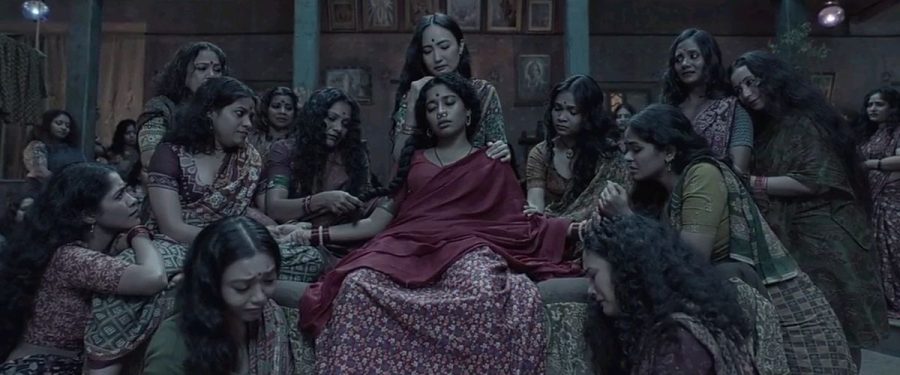Bollywood, one of the largest film industries in the world, holds immense influence in shaping cultural narratives in India and beyond. Known for its larger-than-life storytelling, it has long been critiqued for its portrayal of women through the ŌĆ£male gazeŌĆØ. Coined by feminist theorist Laura Mulvey, this concept highlights how women in media are reduced to objects of desire for male characters and audiences, a pattern that remains deeply embedded in Bollywood.
This is most apparent in BollywoodŌĆÖs song-and-dance sequences, particularly in “item numbers” like ŌĆ£Munni Badnaam HuiŌĆØ and ŌĆ£Sheila Ki JawaniŌĆØ. These songs often feature women in revealing costumes, performing provocative choreography designed to appeal to male spectatorship. Rarely essential to the plot, such sequences prioritize the visual allure of the female body over the character’s depth, reducing women to mere spectacles rather than integral contributors to the narrative.

The visual framing of women further reinforces the male gaze. Female characters are frequently introduced with close-ups that linger on their eyes, lips, or waist, fragmenting their bodies into objects of admiration. In films like ŌĆ£Dilwale Dulhania Le JayengeŌĆØ, SimranŌĆÖs introduction emphasizes her beauty as her defining trait, setting the tone for how the audience should view her. This focus on physicality sidelines the individuality and substance of female characters, aligning their value with how they appeal to male desires.
BollywoodŌĆÖs storytelling also centers menŌĆÖs journeys, with women often relegated to supporting roles. Female leads are typically cast as “love interests,” existing to aid or validate the male protagonist. A glaring example is ŌĆ£Kabir SinghŌĆØ, where Preeti is portrayed as silent and submissive, serving to romanticize unhealthy dynamics. Her lack of depth underscores a troubling narrative trend where female characters exist primarily in relation to the male hero.
BollywoodŌĆÖs portrayal of women often mirrors patriarchal societal norms, categorizing them into rigid archetypes. The ŌĆ£virgin versus vampŌĆØ trope has been a staple for decades, presenting women as either virtuous or morally ambiguous. While the idealized woman is celebrated for her purity, the sexualized “vamp” is often punished or sidelined. This binary reinforces restrictive gender roles, perpetuating stereotypes about womenŌĆÖs value being tied to their adherence to cultural expectations.
However, recent years have seen efforts to challenge these portrayals. Films like ŌĆ£QueenŌĆØ and ŌĆ£PinkŌĆØ have shifted the focus to womenŌĆÖs experiences, moving beyond male-centric narratives. In ŌĆ£QueenŌĆØ, RaniŌĆÖs story of self-discovery unfolds without male validation, while ŌĆ£PinkŌĆØ addresses issues of consent and autonomy, placing womenŌĆÖs voices at the forefront. These films mark a departure from traditional tropes, offering more empowering representations of women.
Female filmmakers are also reshaping BollywoodŌĆÖs gaze by creating narratives that highlight women as complex individuals. Directors like Zoya Akhtar and Meghna Gulzar have brought nuance to female characters, crafting stories that resist objectification. Films like ŌĆ£Gully BoyŌĆØ and ŌĆ£ChhapaakŌĆØ explore themes of resilience and self-expression, signaling a gradual shift in the industry.
Despite these changes, Bollywood continues to grapple with outdated portrayals. The persistent tendency to romanticize toxic dynamics and prioritize male perspectives reveals how deeply entrenched the male gaze remains. But with more voices pushing for diverse and inclusive storytelling, thereŌĆÖs hope for a broader transformation. Have you ever watched a Bollywood movie and noticed how women are portrayed? The next time you do, consider whether their stories are their ownŌĆöor merely reflections of someone elseŌĆÖs gaze.
Reference List
Slatewala, Z. (2019).┬ĀScholar Commons Scholar Commons Graduate Theses and Dissertations Graduate School Objectification of Women in Bollywood Item Numbers Objectification of Women in Bollywood Item Numbers. [online] Available at: https://digitalcommons.usf.edu/cgi/viewcontent.cgi?article=9145&context=etd.
“Queen” (2013). Directed by Vikas Bahl.
“Pink” (2016). Directed by Aniruddha Roy Chowdhury.
“Kabir Singh” (2019). Directed by Sandeep Reddy Vanga.
“Dilwale Dulhania Le Jayenge” (1995). Directed by Aditya Chopra.
Dwyer, R. (2010).┬ĀBollywoodŌĆÖs India: Hindi Cinema as a Guide to Modern India.┬ĀReaktion Books.


What a well written article. You do a great job of pointing out how Bollywood constantly reduces or ignores female characters in storylines that are mostly about men. Using examples from Dilwale Dulhania Le Jayenge and Kabir Singh, you are able to make it very evident how patriarchal standards and the male gaze define women’s roles. Next time, you could talk about how audience expectations affect these changes to make your work stronger. Overall, a very insightful and interesting blog post.
Wow, this gave me a whole new perspective into a world I didn’t know about before and the problems that plague Eastern media just like in Western media. I think it’s awful Bollywood is reducing females in Shows, Films and more and how the issue of the male gaze transcends East and West division.
This is insightful and a real eye-opener towards this awful sexist issue in Bollywood and how it uses the Male Gaze to objectify and discriminate against women.